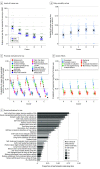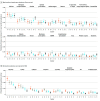Ecological Momentary Assessment of Self-Reported Kratom Use, Effects, and Motivations Among US Adults - PubMed (original) (raw)
Ecological Momentary Assessment of Self-Reported Kratom Use, Effects, and Motivations Among US Adults
Kirsten E Smith et al. JAMA Netw Open. 2024.
Abstract
Importance: Kratom products, which are sold legally in most of the US, contain alkaloids with opioidergic, adrenergic, and serotonergic activity. Millions of people use kratom to relieve pain, improve mood, or self-manage substance use disorders (SUDs). Kratom use has primarily been examined via surveys, in which recall biases among satisfied users may lead to minimization of transient negative outcomes. Further prospective study of kratom use, such as with ecological momentary assessment (EMA), is needed.
Objective: To characterize proximal motivators, effects, and patterns of kratom use and to assess whether use frequency is associated with motivations, effects, past-year criteria for SUD for kratom (KUD), or other substance use.
Design, setting, and participants: For this prospective cross-sectional study, an intensive longitudinal smartphone-based EMA in which participants' current behaviors and experiences were repeatedly sampled in real time was conducted between July 1 and October 31, 2022. Participants comprised a convenience sample of US adults who used kratom at least 3 days per week for at least 4 weeks at the time of online screening. Criteria for past-year KUD were based on the Diagnostic and Statistical Manual of Mental Disorders, Fifth Edition. Data analysis was performed between November 2022 and November 2023.
Exposure: The exposure was 13 401 kratom-use events across 15 days.
Main outcomes and measures: A baseline survey covering demographics, health, kratom attitudes and behaviors, use motivations, other substance use, and KUD was administered before EMA. Data for the following EMA entries were then collected: event-contingent entries for kratom use (product, dose, and proximal motivations), follow-up entries (short-term effects and consequences of use events), random-prompt entries (mood), beginning-of-day entries (effects of kratom on sleep), and end-of-day entries (daily subjective descriptions of kratom effects). Bayesian regression was used to estimate means and credible intervals.
Results: A total of 357 participants completed the EMA. Their mean (SD) age was 38.0 (11.1) years; more than half were men (198 [55.5%]). Participants reported overall motivators of use on the baseline survey that involved managing psychiatric and SUD problems, but proximal motivators evaluated during the EMA involved situation-specific needs such as increasing energy and productivity and decreasing pain. Acute effects were considered congruent with daily obligations. Use patterns, despite having some distinguishing features, were generally similar in their motivators and effects; participants used kratom predominantly during the daytime and seemed to find use frequencies that suited their needs. Higher use patterns were associated with symptoms of physical dependence (eg, withdrawal or tolerance). Co-used substances included caffeine, nicotine, vitamins, and cannabis.
Conclusions and relevance: Most participants in this study reported using kratom in a seemingly nonproblematic way. When such use appeared problematic, the key element was usually that withdrawal avoidance became a proximal motivator. Longitudinal studies examining changes in kratom use patterns and effects over time are needed.
Conflict of interest statement
Conflict of Interest Disclosures: Dr Smith reported receiving grants from the National Institute on Drug Abuse (NIDA) during the conduct of the study and personal fees from the International Plant and Herbal Alliance outside the submitted work. Dr Grundmann reported representing parties in legal disputes related to kratom use resulting in impairment or death. Dr Dunn reported consulting for Mind Med Inc and DemeRx, participating as an advisory board member for Cessation Therapeutics, and serving as a study steering committee member for Indivior outside the submitted work. Dr Dunn also reported receiving funding for studies through Johns Hopkins University School of Medicine from the NIDA and Cure Addiction Now outside the submitted work. Dr Garcia-Romeu reported serving as a scientific advisor and receiving personal fees from Innerwell, NeonMind Biosciences, and ETHA Natural Botanicals outside the submitted work. No other disclosures were reported.
Figures
Figure 1.. Characteristics of Kratom Use Obtained From Baseline Survey and Ecological Momentary Assessment (EMA)
A, Mean number of uses per day as reported in the survey (referring to the 30 days before the survey, which was conducted before EMA) and in EMA reports that indicated time of each use event. Clusters represent subgroups of participants with similar patterns of use (most frequent in cluster A, and least frequent in cluster E). B, Daily variability in the number of uses per day in each cluster (expressed as the coefficient of variation), with the frequent-use clusters A and B showing less variation. C, Proximal motivations endorsed in event-contingent reports of use. Motivations were generally similar across clusters, but variability was lowest in frequent-use clusters A and B. D, Acute effects of kratom, as described in follow-up reports obtained at random times within 2 hours after a use-event report. Effects were generally similar across clusters. E, Broad motivations for kratom use across all participants (ie, regardless of cluster), with bar length indicating the proportion of participants endorsing the item and with shading indicating the average rating of kratom's effectiveness for each purpose, as reported in the survey of important factors that influence or motivate the participant’s kratom use. In A to E, large points and error bars represent the bayesian 90% credible interval for the measure. Small points (when present) represent data (randomly jittered horizontally) for individual participants. Nonoverlapping error bars provide a conservative indication of a reliable difference between conditions. In C to E, data were obtained by giving the participant a list from which all items that applied could be endorsed. Clustering was based in part on the EMA data summarized in the first panel, but also on within-day patterns of use (not shown). The legend (or order of bars in E) shows the items in order of decreasing overall prevalence (ie, in all participants, regardless of cluster); items that were not endorsed by at least 10% of at least 1 cluster were excluded from analysis. ADD indicates attention-deficit disorder; ADHD, attention-deficit/hyperactivity disorder.
Figure 2.. Nonkratom Substance Preferences and Use
A, Most-preferred nonkratom substances, in response to the survey item (“Thinking about all of the drugs you have ever tried, please select your five most preferred substances, meaning the substances you received the most all around satisfaction from”). B, Nonkratom substances used during the study, as reported in the ecological momentary assessment (EMA). The mean and the 90% credible interval are reported for each cluster. Items are shown in order of decreasing overall prevalence (ie, across all participants); items that were not endorsed by at least 10% of at least 1 cluster were excluded from analysis. For many measures, the kratom-use clusters were similar to each other, with some clear exceptions (mostly in cluster E, who had the least frequent use) as discussed in the Results. MDMA indicates methylenedioxymethamphetamine.
Figure 3.. Motivations for and Effects of Kratom Use
A, Main reason for kratom use that day. B, Judgement of whether kratom had the desired results and effects the participant wanted that day. C, Overall characterization of kratom effects experienced that day. D, Assessment of whether kratom was a help or hindrance to productivity that day. E, Assessment of whether kratom was a help or hindrance to participants being able to live out their day and do what they wanted or needed to do. Data in all panels are from end-of-day reports.
Figure 4.. Symptoms Associated With Kratom Use
A, Number of kratom-related Diagnostic and Statistical Manual of Mental Disorders, Fifth Edition (DSM-5) symptoms endorsed within the participant’s lifetime for each cluster (means in black) and for each participant (points, colored by cluster). B, Probability of endorsement of each _DSM_-5 symptom within each cluster. Points and error bars represent means and 90% credible intervals.
Similar articles
- Time course of kratom effects via ecological momentary assessment, by product type, dose amount, and assayed alkaloid content.
Smith KE, Panlilio LV, Sharma A, McCurdy CR, Feldman JD, Mukhopadhyay S, Kanumuri SRR, Kuntz MA, Hill K, Epstein DH. Smith KE, et al. Drug Alcohol Depend. 2024 Nov 1;264:112460. doi: 10.1016/j.drugalcdep.2024.112460. Epub 2024 Oct 10. Drug Alcohol Depend. 2024. PMID: 39405600 - Kratom addiction per DSM-5 SUD criteria, and kratom physical dependence: Insights from dosing amount versus frequency.
Rogers JM, Weiss ST, Epstein DH, Grundmann O, Hill K, Smith KE. Rogers JM, et al. Drug Alcohol Depend. 2024 Jul 1;260:111329. doi: 10.1016/j.drugalcdep.2024.111329. Epub 2024 May 20. Drug Alcohol Depend. 2024. PMID: 38788532 Free PMC article. - Exploring the self-reported motivations of kratom (Mitragyna speciosa Korth.) use: a cross-sectional investigation.
Grundmann O, Veltri CA, Morcos D, Knightes D 3rd, Smith KE, Singh D, Corazza O, Cinosi E, Martinotti G, Walsh Z, Swogger MT. Grundmann O, et al. Am J Drug Alcohol Abuse. 2022 Jul 4;48(4):433-444. doi: 10.1080/00952990.2022.2041026. Epub 2022 Apr 7. Am J Drug Alcohol Abuse. 2022. PMID: 35389321 - Controversies in Assessment, Diagnosis, and Treatment of Kratom Use Disorder.
Smith KE, Epstein DH, Weiss ST. Smith KE, et al. Curr Psychiatry Rep. 2024 Sep;26(9):487-496. doi: 10.1007/s11920-024-01524-1. Epub 2024 Aug 13. Curr Psychiatry Rep. 2024. PMID: 39134892 Free PMC article. Review.
Cited by
- Time course of kratom effects via ecological momentary assessment, by product type, dose amount, and assayed alkaloid content.
Smith KE, Panlilio LV, Sharma A, McCurdy CR, Feldman JD, Mukhopadhyay S, Kanumuri SRR, Kuntz MA, Hill K, Epstein DH. Smith KE, et al. Drug Alcohol Depend. 2024 Nov 1;264:112460. doi: 10.1016/j.drugalcdep.2024.112460. Epub 2024 Oct 10. Drug Alcohol Depend. 2024. PMID: 39405600 - Kratom safety and toxicology in the public health context: research needs to better inform regulation.
Henningfield JE, Grundmann O, Huestis MA, Smith KE. Henningfield JE, et al. Front Pharmacol. 2024 Jun 3;15:1403140. doi: 10.3389/fphar.2024.1403140. eCollection 2024. Front Pharmacol. 2024. PMID: 38887550 Free PMC article. Review. - Commentary: Presence of kratom in opioid overdose deaths: findings from coroner postmortem toxicological report.
Grundmann O, Smith KE, Prozialeck WC, Veltri CA, Boyer EW. Grundmann O, et al. Front Psychiatry. 2024 May 23;15:1411964. doi: 10.3389/fpsyt.2024.1411964. eCollection 2024. Front Psychiatry. 2024. PMID: 38846916 Free PMC article. No abstract available. - Effects of kratom on driving: Results from a cross-sectional survey, ecological momentary assessment, and pilot simulated driving Study.
Zamarripa CA, Spindle TR, Panlilio LV, Strickland JC, Feldman JD, Novak MD, Epstein DH, Dunn KE, McCurdy CR, Sharma A, Kuntz MA, Mukhopadhyay S, Raju KSR, Rogers JM, Smith KE. Zamarripa CA, et al. Traffic Inj Prev. 2024;25(4):594-603. doi: 10.1080/15389588.2024.2327827. Epub 2024 Mar 18. Traffic Inj Prev. 2024. PMID: 38497810 - Growing pains with kratom: experiences discussed in subreddits contrast with satisfaction expressed in surveys.
Rogers JM, Colvin K, Epstein DH, Grundmann O, McCurdy CR, Smith KE. Rogers JM, et al. Front Pharmacol. 2024 Jun 14;15:1412397. doi: 10.3389/fphar.2024.1412397. eCollection 2024. Front Pharmacol. 2024. PMID: 38948457 Free PMC article.
References
- Glover MM. The marketing of self-care and alternative therapies in the US in 2019: how industry stakeholders appeal to consumers’ perceptions of novel food products and additives. J Food Law Policy. 2019;15(2):48.
- Mukhopadhyay S, Gupta S, Wilkerson JL, Sharma A, McMahon LR, McCurdy CR. Receptor selectivity and therapeutic potential of kratom in substance use disorders. Curr Addict Rep. 2023;10(2):304-316. doi:10.1007/s40429-023-00472-9 - DOI
- Obeng S, Kamble SH, Reeves ME, et al. . Investigation of the adrenergic and opioid binding affinities, metabolic stability, plasma protein binding properties, and functional effects of selected indole-based kratom alkaloids. J Med Chem. 2020;63(1):433-439. doi:10.1021/acs.jmedchem.9b01465 - DOI - PMC - PubMed
- Obeng S, Leon F, Patel A, et al. . Interactive effects of µ-opioid and adrenergic-α2 receptor agonists in rats: pharmacological investigation of the primary kratom alkaloid mitragynine and its metabolite 7-hydroxymitragynine. J Pharmacol Exp Ther. 2022;383(3):182-198. doi:10.1124/jpet.122.001192 - DOI - PMC - PubMed
Publication types
MeSH terms
LinkOut - more resources
Full Text Sources
Medical
Research Materials
Miscellaneous



